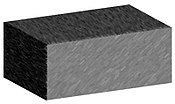| Revision as of 17:39, 20 June 2003 editPatrick (talk | contribs)Edit filter managers, Administrators68,523 editsmNo edit summary | Revision as of 17:56, 7 August 2006 edit undoFireplace (talk | contribs)Extended confirmed users, Rollbackers5,915 edits moving from shadeNext edit → | ||
| Line 1: | Line 1: | ||
| {{dablink|For other uses, see ].}} | |||
| #REDIRECT ] | |||
| ] | |||
| '''Shading''' is a process used in drawing for depicting levels of darkness on paper by applying more pressure with a drawing implement for darker areas, and less pressure for lighter areas. There are various techniques of shading including ] where perpendicular lines of varying closeness are drawn in a grid pattern to shade an area. The closer the lines are together, the darker the area appears and vice versa. | |||
| The term has been recently generalized to mean that ]s are applied. | |||
| Light patterns, such as objects having light areas and shaded areas, help when creating the illusion of depth on paper and on computer screens. | |||
| == See also == | |||
| ]. | |||
Revision as of 17:56, 7 August 2006
For other uses, see Shade (disambiguation).
Shading is a process used in drawing for depicting levels of darkness on paper by applying more pressure with a drawing implement for darker areas, and less pressure for lighter areas. There are various techniques of shading including cross hatching where perpendicular lines of varying closeness are drawn in a grid pattern to shade an area. The closer the lines are together, the darker the area appears and vice versa. The term has been recently generalized to mean that shaders are applied.
Light patterns, such as objects having light areas and shaded areas, help when creating the illusion of depth on paper and on computer screens.